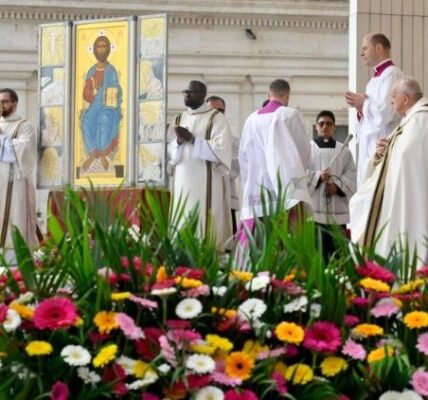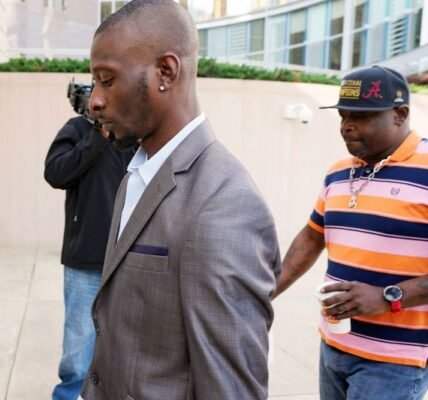Ram Mandir: Humiliating Shock for Narendra Modi’s Mega-Hyped Vanity Project – The Daily Beast
AYODHYA, India—It was supposed to be an iconic moment to cement Prime Minister Narendra Modi’s place as one of the greatest Hindu nationalists in Indian history, but despite all the fanfare and celebrations he has failed to deliver.
When the massive, controversial new Hindu temple is inaugurated before a vast crowd on Monday, the complex will not be finished.
One worshiper who journeyed to Ayodhya with six priests on a pilgrimage to Ram Mandir—this great symbol of Hindu nationalism—couldn’t conceal his disappointment when he arrived at the site.
“An incomplete home is a disrespect in our script for Lord Ram,” Lakshman Das Nirmohi, 55, from Ahmedabad, told The Daily Beast.
The temple is being constructed on the site where a 16th-century Muslim temple, called the Babri Masjid, was demolished by a mob of around 150,000 Hindus on Dec. 6, 1992, while the authorities watched on. A series of violent riots that followed left around 2,000 people dead—most of them Muslims.
Rewarding the destruction and violence by replacing the Muslim holy site with a gaudy celebration of Hinduism is a hammer blow to India’s Islamic minority, who have seen their rights eroded under a decade of Modi’s rule. It is also seen as the crowning glory of Modi’s championing of Hindutva—turning India into a Hindu nation.
“
Muslims are being told to accept injustice as justice.
”
Away from the headlines, here in the sacred city of Ayodhya, the construction of the temple is quite clearly still ongoing. The pathways leading to the main entrance are strewn with machinery, dust, construction materials, and workers diligently engaged in repairing the walls that delineate the temple complex from the nearby market and a few surrounding houses.
It looks like a construction site.
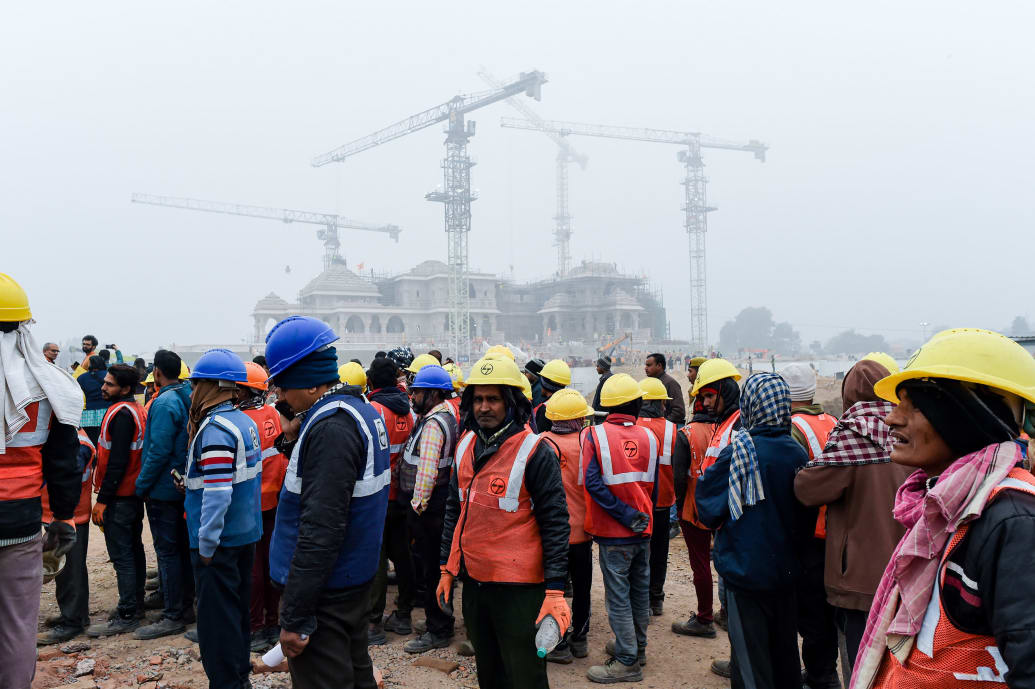
Workers are seen at construction site for the temple of Hindu Lord Ram on December 29, 2023 in Ayodhya, India.
Ritesh Shukla/Getty Images
Fervent Hindus from all corners of India are already visiting, expressing gratitude to the BJP for fulfilling their dreams. The devotees patiently queue up through extensive security checks, yearning for a glimpse of the Ram Mandir beyond the metal barriers. The area is enclosed in wires and barricades to maintain an uninterrupted construction process. From a distance, devotees can only view the pillars and tomb of the shrine, offering their respects from afar.
Once they discover that the temple has not been completed, concerns arise.
Ravi Kanth Tiwari, who played an active role in organizing the mob that dismantled the Babri Masjid, was unimpressed.
“This is not creating a favorable impression for devotees, as we can only witness a partially constructed Mandir. It appears that it will take another four or five years for completion. If the temple had been finished entirely, it would have presented a more appealing sight,” he told The Daily Beast.
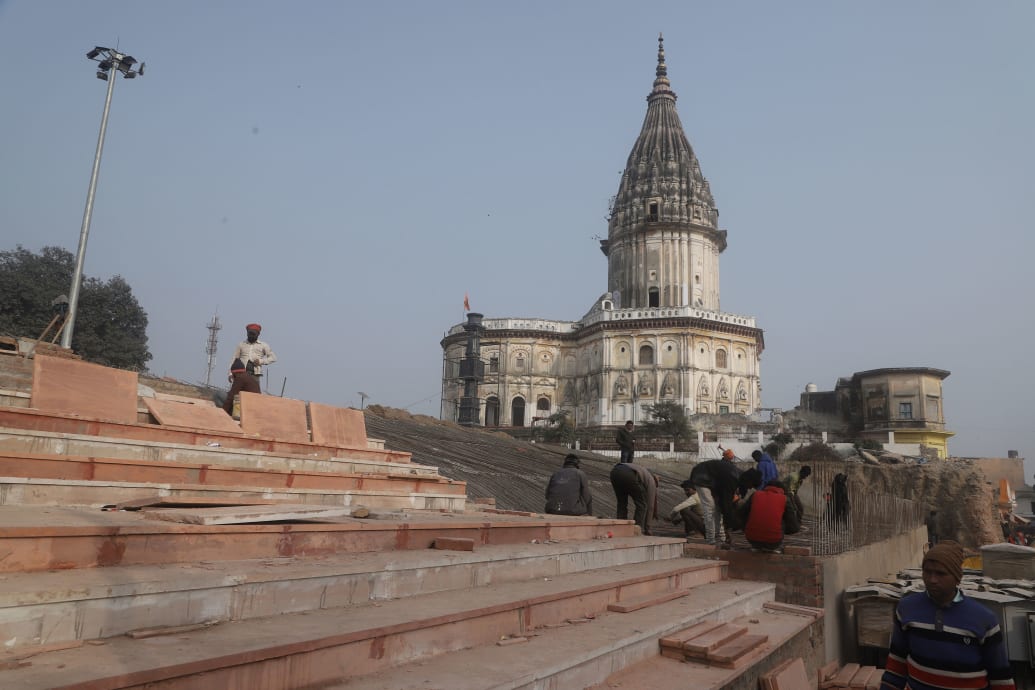
The work outside the Ram Mandir and its access paths is operating round the clock in shifts as the deadline approaches.
Bhat Burhan
Prakash Kumar, a site engineer from Tata Consultancy, told The Daily Beast that they were working 24/7 to complete the pillars and flooring inside the temple in time for the inauguration. He admitted that the entire Mandir complex would not be completed until 2027.
While much of the pro-Modi media and cheerleaders for his Bharatiya Janata Party (BJP) are celebrating the new temple, some ultra-religious Hindus are raising concerns.
The heads of the four Hindu monasteries, known as the Shankaracharyas, have refused to attend.
“The construction of the Mandir is still ongoing, and they are inaugurating it without any compelling reason to rush. Expressing our reservations and choosing not to partake in the inauguration has led to us being labeled as anti-Modi,” explained top spiritual leader Jyotiramath Shankaracharya.
Another of the Shankaracharyas was even more scornful. “Modi will inaugurate the temple, he will touch the idol, then what am I supposed to do? Stand and clap?” said Puri Shankaracharya.
Turning Religion Into Votes
The temple which spreads over 2.7 acres, stands near the site revered as the birthplace of Lord Ram, a Hindu deity that symbolizes the triumph of good over evil. On Jan. 22, Modi will preside over the ceremony as they move an idol of Lord Ram, into the temple’s inner sanctum.
It will complete the transformation of Ayodhya into an icon of the Hindutva nation, a project promoted by the ruling BJP government since they assumed power in 2014. The entire city is adorned with saffron hues on walls, graffiti of Hindu deities on shop shutters, and the sounds of Hindu hymns echo from temples scattered around the Ram Mandir.
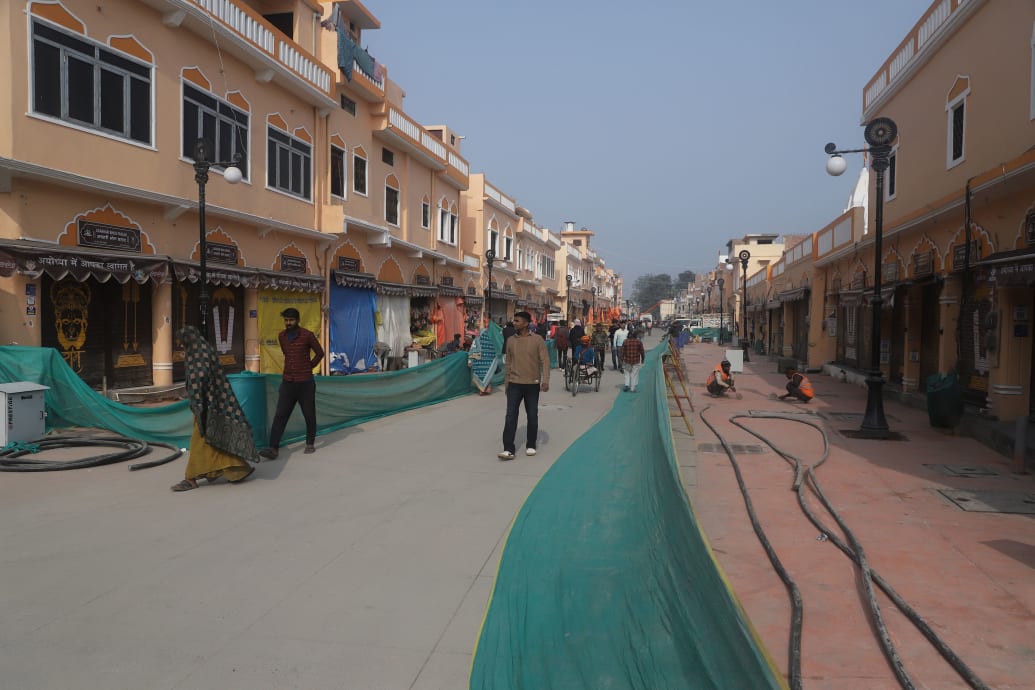
The work is progressing at a rapid pace in preparation for the inauguration of the Ram Mandir.
Bhat Burhan
The BJP and its allied right-wing groups have generated considerable anticipation and promotion surrounding the inauguration, underscoring the unparalleled significance of this temple in India.
“Modi has turned our 500-year-old dream and struggle into reality, a feat no previous prime minister has achieved for our country. The foundation for this temple was laid back on December 6, 1992, when Hindu Kar Sevaks demolished the mosque structure. Now, it’s our time to celebrate that victory,” Rajendra Sharma, a devotee, told The Daily Beast.
For Prime Minister Modi, this achievement goes beyond mere brick and mortar; it represents an ideological triumph, a kind of coronation, which he hopes will lead him to a historic third term in office.
The event has been timed to coincide with the upcoming 2024 parliamentary elections, where Modi expects to crush his rivals..
Just as the Babri demolition—which followed speeches by top BJP leaders—played a pivotal role in bringing sectarian politics to the fore in India, the inauguration of the temple is another mechanism aimed at consolidating polarization, and reaping the electoral dividends of further empowering the Hindu majority, who make up 80 percent of the country’s population.
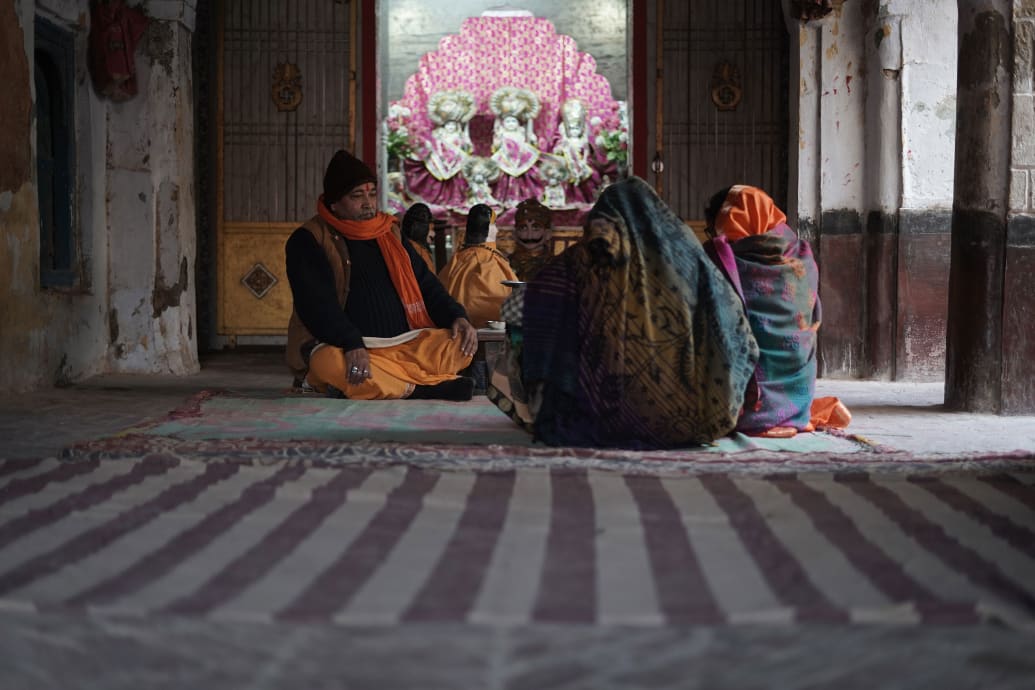
Pilgrims offering prayers inside the temple beside Ram Mandir.
Bhat Burhan
The government has already secured substantial backing in the previous two terms, leveraging its commitment to the idea of India as a Hindu nation.
The meticulous preparation and promotion of the inauguration of the Ram Mandir is a clear signal from Modi that the concept of India as a secular nation, which is enshrined in its post-independence constitution, is dead.
As the inauguration of the temple approaches, extensive efforts are being made to mobilize a substantial number of Hindus for the occasion. Special trains and buses are being laid on for the occasion with around 8,000 VIPs expected to be joined by more than 100,000 people in Ayodhya on the day.
Screenings are planned not only across the country but also at Indian embassies worldwide, with a sponsored display even scheduled for Times Square in New York. Dozens of billboards in states like Texas, Illinois, New York, New Jersey, and Georgia have also been installed with messages about the upcoming ceremony.
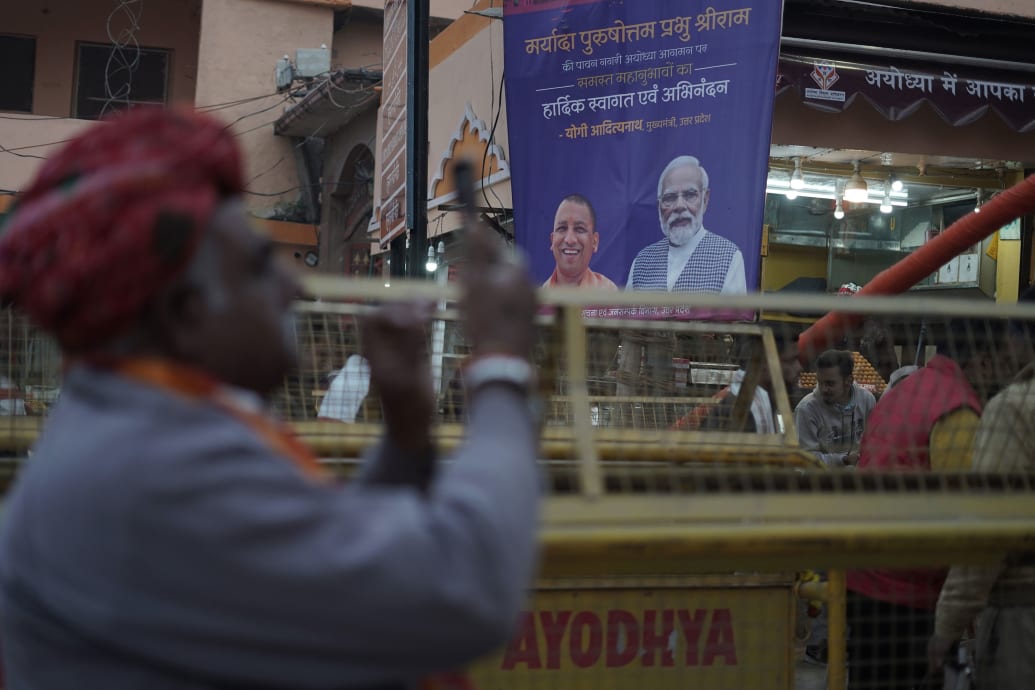
The city of Ayodhya is adorned with hoardings featuring Narendra Modi and the state’s chief minister Yogi Adityanath in anticipation of the Ram Mandir inauguration.
Bhat Burhan
The right-wing Hindu nationalist, paramilitary organization RSS, which was banned under previous governments for fomenting violence, has been activated to rally Hindus, urging them either to visit the new temple or to take part in rituals at their local temples.
The RSS, which was instrumental in launching Modi’s political career and of which he remains a member, is actively garnering support for Modi and his Hindu-centric policies on WhatsApp groups and other social media to disseminate videos showcasing Modi’s commitment to the construction of the Ram Mandir.
Punching Down on Muslims
The rapid transformation of Ayodhya has instilled fear among the Muslim minority communities residing on the outskirts of the main town. Approximately a mile and a half away from the Mandir, a mosque named Malik Shah Masjid stands, surrounded by a few Muslim families who now stay indoors to avoid potential clashes with Hindu rallies and right-wing groups passing by on the road to the Mandir.
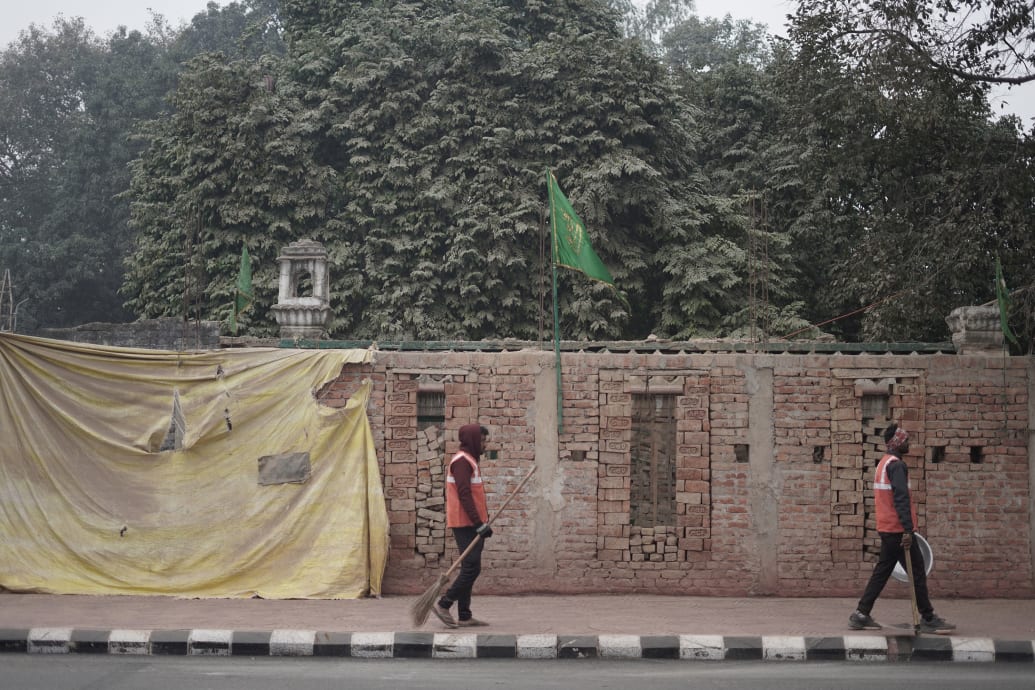
The newly constructed wall on the site of a Muslim shrine, which was demolished for the development of Ayodhya city.
Bhat Burhan
Adjacent to the mosque, a small shrine of a Muslim saint was demolished 10 months ago, reportedly as part of the process to transform Ayodhya into a model city for temple visitors. According to the Masjid’s caretaker, attempts were made a few days ago to paint the outer walls and front side of the Masjid with saffron color, a move that he resisted.
Mohammad Shazaad, 55, said his family mourned the desecration of the shrine for days. The second-generation caretaker of the 500-year-old masjid was an eyewitness to the 1992 demolition of the Babri Masjid.
“I will give my life to resist any changes to this masjid’s original form. I have instilled the same teachings in my two sons, and they would follow suit,” he told The Daily Beast.
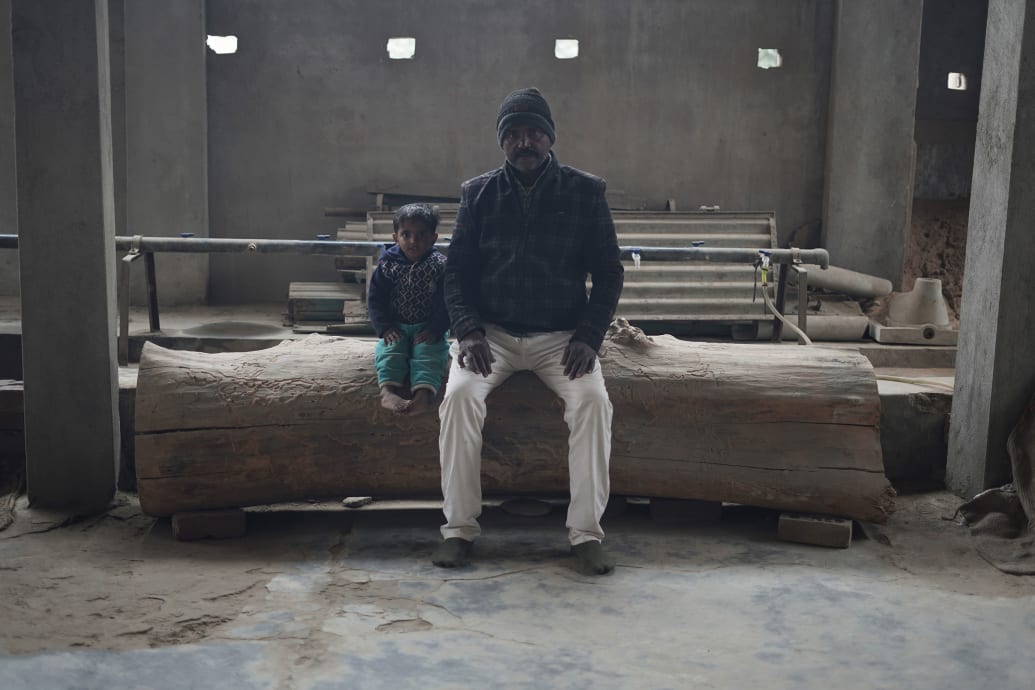
Mohammad Shazaad, the second-generation caretaker of Malik Shah Masjid in Ayodhya.
Bhat Burhan
Not only Muslims but a substantial number of traders in the town are dissatisfied with the government’s plan for a new city. Nand Kumar, the head of the traders’ association, revealed that they suffered significant losses when the Ayodhya Development Authority demolished their shops for road widening two years ago, and the construction is still ongoing.
Kumar expressed discontent over the lack of compensation for the land taken for road expansion, with many shopkeepers losing a significant portion of their businesses. Fearful of police retaliation, Kumar said, “We are scared of raising our voice against it.”
For the Muslims in Ayodhya, the extensive pride and celebration surrounding the Ram Mandir serve as a painful reminder of the hijacking of the Babri Masjid and the subsequent Supreme Court decision awarding the entire area to the Hindus. Land allocated for the construction of a new masjid—around 15 miles away from the Ram Mandir—has yet to witness any progress.
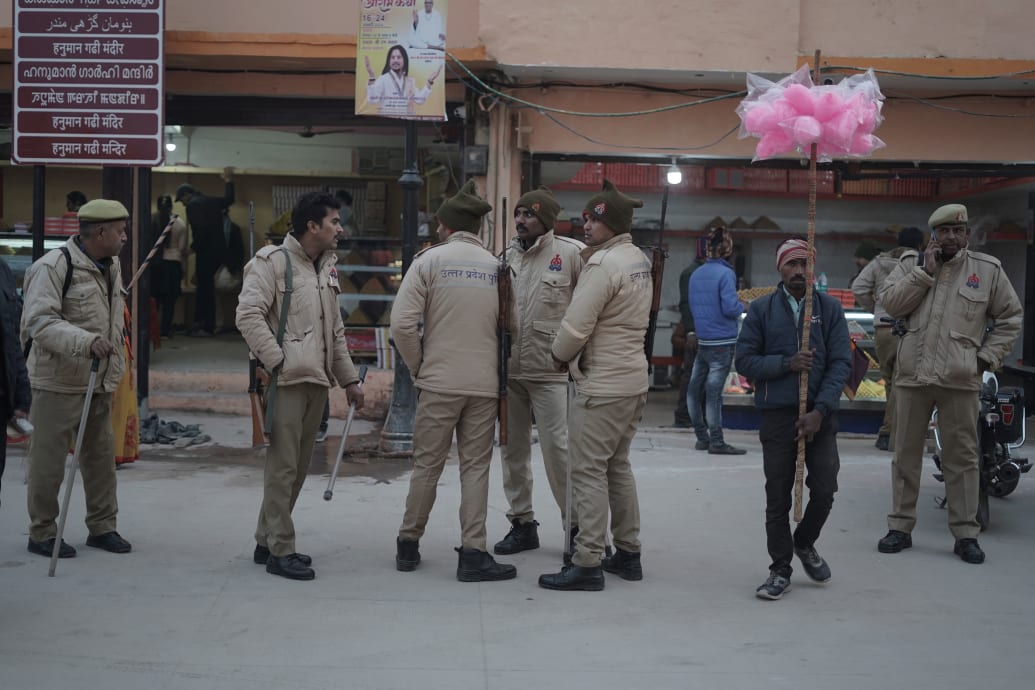
Uttar Pradesh police personnel stand guard along the path leading to Ram Mandir, announcing instructions for visitors to deposit their mobile phones and bags before entering the temple premises.
Bhat Burhan
Looking at the land allocated for the new mosque, which is far from the local Muslim community, the only indication of progress is a sign displaying the design of the masjid and other planned structures. The vacant space, enclosed by agricultural fields, currently serves as a grazing area for local cattle and a playing field.
“I don’t think we will ever witness the construction of the masjid directed by the Supreme Court here because the BJP has worsened our lives by promoting the ideology of a Hindutva nation for India,” Jan Mohammad, who lives in the nearby village of Dhanipur, told The Daily Beast.
He questions the assertion by BJP leaders that the new masjid will surpass the Taj Mahal. “How can a government and its supporters permit the construction of a masjid when they are still targeting mosques, engaging in violence against Muslims, and issuing threats for them to leave the country?” he said.
Damaging Muslim communities is more than an oversight.
Since assuming power, the BJP’s political discourse has significantly heightened tensions between Hindus and Muslims. Through the redefinition and reshaping of Indian citizenship based on the principles of Hindutva, the BJP government has disrupted the longstanding commitment to secularism and the idea of India. Consequently, a marginalized Muslim community now finds itself relegated to the fringes, treated as second-class citizens within a more segregated framework.
It is no coincidence that two of the most significant initiatives announced by Modi’s government in 2014—which have loomed large ever since—were both bitterly opposed by India’s community of over 200 million Muslims.
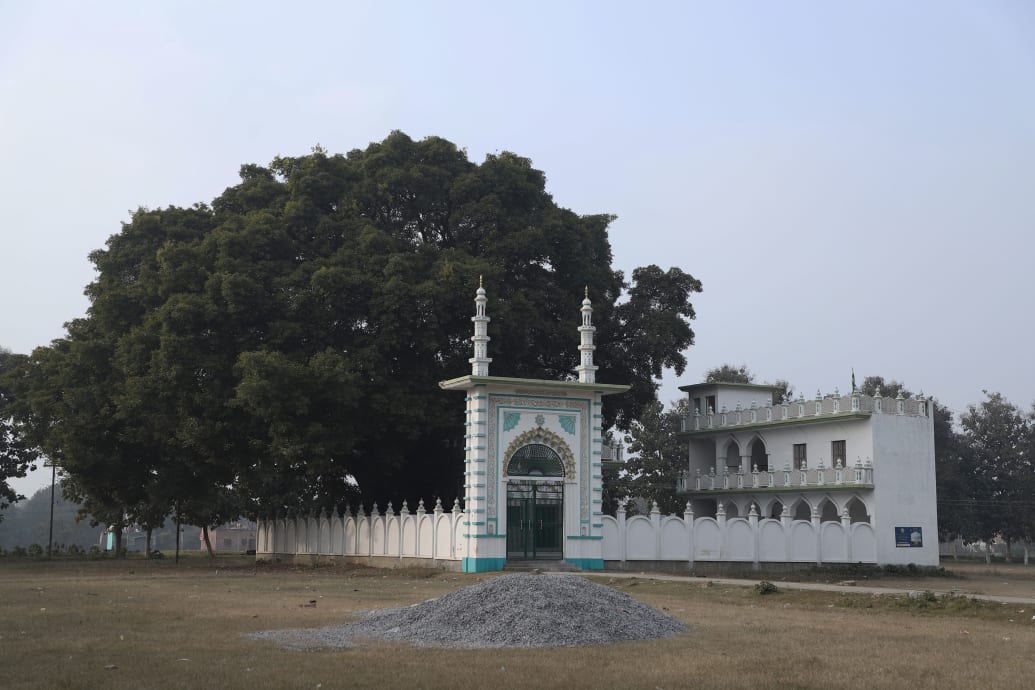
The waste ground that has been allocated as a site for the new mosque.
Bhat Burhan
One was the construction of this temple, and that was closely followed by the revocation of Article 370 of the Indian Constitution, which granted semi-autonomy to Indian Administered Kashmir. Despite facing staunch criticism from political rivals and the minority community, the prime minister remained committed to both promises.
Delhi University professor and political analyst Apoorvanand said the whole point of the Ram Mandir was to show supremacy over Muslims—a symbol of supreme injustice sanctioned by the highest court in the land.
“Muslims are being told to accept injustice as justice, celebrating and validating it within society, including political parties,” he said. “This undoubtedly aims to bolster the Hindu vote bank for parties involved in the exercise, serving as the precise objective of the entire endeavor.”
